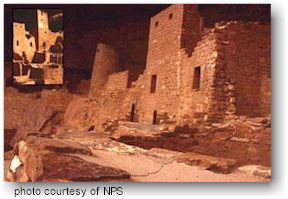


|

|
 Cliff Palace in Mesa Verde National Monument |
 Coyote Valley Trail in Rocky Mountain National Park |
| Bent's
Old Fort National Historic Site - William and Charles
Bent, along with Ceran St. Vrain, built the original fort on this site
in 1833 to trade with plains Indians and trappers. The adobe fort
quickly became the center of the Bent, St.Vrain Company's expanding
trade empire that included Fort St.Vrain to the north and Fort Adobe to
the south, along with company stores in Mexico at Taos and Santa Fe. The
primary trade was with the Southern Cheyenne and Arapaho Indians for
buffalo robes.
Black Canyon of the Gunnison National Park - The Black Canyon of the Gunnison's unique and spectacular landscape was formed slowly by the action of water and rock scouring down through hard Proterozoic crystalline rock. No other canyon in North America combines the narrow opening, sheer walls, and startling depths offered by the Black Canyon of the Gunnison. California National Historic Trail - The California Trail carried over 200,000 gold-seekers and farmers to the gold fields and rich farmlands of California during the 1840's and 1850's, the greatest mass migration in American history. Today, more than 1,000 miles of trail ruts and traces can still be seen in the vast undeveloped lands between Casper Wyoming and the West Coast, reminders of the sacrifices, struggles, and triumphs of early American travelers and settlers. Colorado National Monument - Established May 24, 1911, and on 20,453.93 acres, Colorado National Monument consists of geologic features including: towering red sandstone monoliths, deep, sheer-walled canyons, and a variety of wildlife (bighorn sheep, golden eagles, mule deer and mountain lions). Curecanti National Recreation Area - Three lakes, named for corresponding dams on the Gunnison River, form the heart of Curecanti National Recreation Area. Panoramic mesas, fjord-like lakes, and deep, steep and narrow canyons abound. Blue Mesa Lake is Colorado's largest body of water, and is the largest Kokanee Salmon fishery in the United States. Morrow Point Lake is the beginning of the Black Canyon of the Gunnison and below, Crystal Lake is the site of the Gunnison Diversion Tunnel, a National Historic Civil Engineering Landmark. Recently discovered dinosaur fossils, a 5,000 acre archeological district, a narrow gauge train, and traces of 6000 year old dwellings further enhance the offerings of Curecanti. Old Spanish National Historic Trail - The Old Spanish Trail was a pack mule trail linking land-locked New Mexico with coastal California between 1829 and 1848. Over this trail moved people, goods, and ideas. Recognizing the national significance of this historic long distance trade route, in 2002 Congress designated it the Old Spanish National Historic Trail. Hovenweep National Monument - Hovenweep National Monument protects some of the finest examples of ancient stone architecture in the southwest. The inhabitants of Hovenweep were part of the large farming culture which occupied the Four Corners region of Utah, Colorado, New Mexico, and Arizona from about 500 B.C. until nearly A.D. 1300. |
Florissant Fossil Beds National Monument - A beautiful mountain valley just west
of Pikes Peak holds spectacular remnants of the earth's prehistoric
life. Huge petrified redwoods and incredibly detailed fossils of ancient
insects and plants reveal a very different Colorado of long ago. Almost
35 million years ago, enormous volcanic eruptions buried the then-lush
valley and petrified the redwood trees that grew there. A lake formed in
the valley and the fine-grained sediments at its bottom became the final
resting-place for thousands of insects and plants. These sediments
compacted into layers of shale and preserved the delicate details of
these organisms as fossils.
Great Sand Dunes National Monument - Nestled in southern Colorado, North America's tallest dunes rise over 700 feet high against the rugged Sangre de Cristo Mountains. The wind shaped dunes glow beneath the rugged backdrop of the mountains, creating a memorable scene. This geologic wonderland, containing 39 square miles of dunes, became a national monument in 1932. Mesa Verde National Park - Mesa Verde National Park has the finest examples of Ancestral Puebloan structures and cliff dwellings in the world, dating from about 550AD to about 1300AD. Pony Express National Historic Trail - he Pony Express National Historic Trail was used by young men on fast paced horses to carry the nation's mail across the country, from St. Joseph, Missouri to Sacramento, California, in the unprecedented time of only ten days. Organized by private entrepreneurs, the horse-and-rider relay system became the nation's most direct and practical means of east-west communications before the telegraph. Though only in operation for 18 months, between April 1860 and October 1861, the trail proved the feasibility of a central overland transportation route, and played a vital role in aligning California with the Union in the years just before the Civil War. Rocky Mountain National Park - The park's rich scenery typifies the massive grandeur of the Rocky Mountains. Trail Ridge Road crosses the Continental Divide and looks out over peaks that tower more than 14,000 feet high. Wildlife and wildflowers call these 415.2 square miles (265,727 acres) of Colorado's front range, home. The road is closed over the winter. During the winter months snowshoeing is popular as is cross country skiing. Dinosaur National Monument - Excavations were started here in 1909 and numerous fossil specimens found here are displayed in museums around the world. When the excavations ended, over 1500 fossils were left in place on the cliff face so visitors can view them as they were found. Fossils at Dinosaur National Monument represent only 10 of the many dinosaur species that existed. Yucca House National Monument - Yucca House National Monument is a large, unexcavated Ancestral Puebloan surface site. Yucca House is located in Southwest Colorado between the towns of Towaoc and Cortez. |
|
|
|
For more information visit the National Park Service website
|
|||